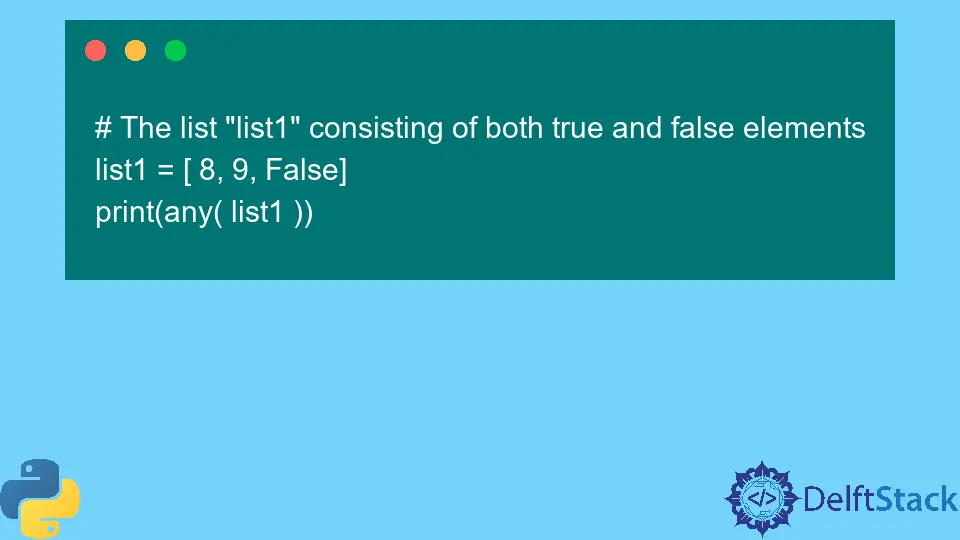Python 中的 any() 函数

本教程演示了 Python 中可用的 any() 函数的使用。
any() 函数是一个简单的 Python 内置函数,它遍历给定可迭代对象的元素,并提供 True 或 False 值,指示可迭代对象中给定元素对中的任何一个在布尔环境中是否是 True。
简单来说,当给定可迭代对象中的任何一项为 True 时,any() 函数将返回 True。从技术上讲,any() 函数的工作可以被认为与对给定迭代中的一组元素执行 OR 操作完全相同。
any() 函数的语法是:
any(iterable)
any() 函数只接受一个参数,它可以是任何给定的可迭代对象。
any() 函数可以返回的所有可能值是,
- 如果发现给定可迭代对象的任何一个元素为
True,则返回True值。 - 如果发现给定可迭代对象的所有元素都是
False,则返回False值。
all() 函数在语法方面类似于 any() 函数,唯一的区别是当给定迭代中的所有项都为 true 时,则 all() 函数返回 True,否则在所有其他情况下返回 False。all() 函数在技术上的行为类似于对每个可迭代元素的 AND 操作。
any() 函数是通用的,可以与各种迭代器一起使用。
在 Python 列表中使用 any() 函数
列表是可在 Python 中使用的四种基本内置数据类型之一,用于将多个项目聚集在单个变量中。列表是可变的、有序的,并且有确定的数量。
any() 函数可以通过以下方式在 Lists 上使用。
# The list "list1" consisting of both true and false elements
list1 = [8, 9, False]
print(any(list1))
上面的代码提供了以下输出:
True
在 Python 元组中使用 any() 函数
元组是 Python 中提供的四种基本数据类型中的另一种,其工作方式与列表类似。元组是有序且不可更改的。
any() 函数可以通过以下方式在元组上使用。
# The tuple "tuple1" consisting of both true and false elements
tuple1 = (8, 9, False)
print(any(tuple1))
上面的代码提供了以下输出:
True
在 Python 集合中使用 any() 函数
总的来说,集合执行相同的功能,将多个项目存储在单个变量中,就像其他三种内置数据类型一样。唯一的区别是集合是无序和无索引的。
any() 函数可以通过以下方式在集合上使用。
# The set "set1" consisting of both true and false elements
set1 = {1, 2, 0, 8, False}
print(any(set1))
上面的代码提供了以下输出:
True
在 Python 字典中使用 any() 函数
四个中的最后一个是字典。字典以 key: value 对的形式存储数据。any() 函数的多功能性使其也可以与字典一起使用。
any() 函数可以通过以下方式在字典上使用。
# The dictionary "dict1" consisting of both true and false elements
dict1 = {1: "Hey", 2: "Great", 3: "Car"}
print(any(dict1))
上面的代码提供了以下输出:
True
any() 函数是 Python 提供的一个方便的工具,当程序员必须处理复杂的条件声明和布尔值时,它可以有效地发挥作用。
Vaibhhav is an IT professional who has a strong-hold in Python programming and various projects under his belt. He has an eagerness to discover new things and is a quick learner.
LinkedIn